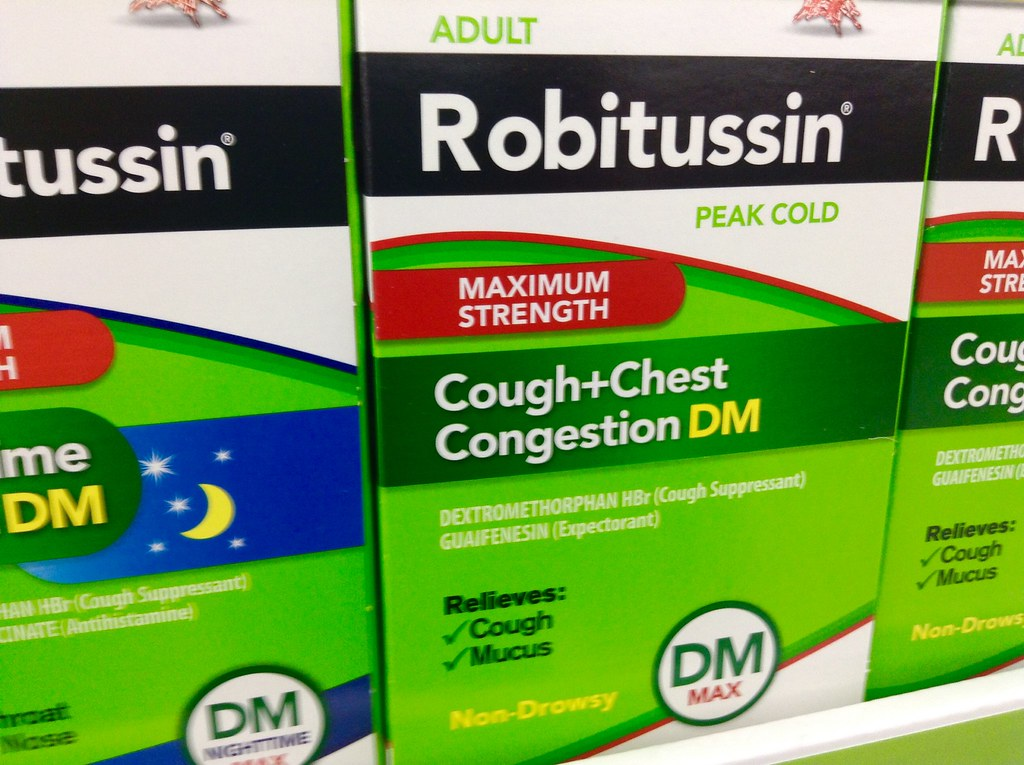5.8 Antitussives
Dextromethorphan
Dextromethorphan is an example of an antitussive (see Figure 5.10[1]).
Mechanism of Action: Dextromethorphan suppresses a cough by depressing the cough center in the medulla oblongata or the cough receptors in the throat, trachea, or lungs, effectively elevating the threshold for coughing.
Indications: Antitussives are used for a dry, hacking, nonproductive cough that interferes with rest and sleep.
Nursing Considerations: This medication is not safe for children under the age of 4 years.
Side Effects/Adverse Effects: The most common side effects include nausea and drowsiness. Some clients may experience a rash or difficulty breathing. High doses may cause hallucinations and disassociation, and the drug has been reported to be used as a recreational drug.[2]
Health Teaching & Health Promotion: Clients should take care to avoid irritants that stimulate their cough, such as smoking. Additionally, antitussive medications can cause drowsiness, and clients should avoid taking them with other CNS depressants or alcohol.[3]

Now let’s take a closer look at the medication grid on dextromethorphan & benzonatate in Table 5.8a.[4],[5],[6]
Table 5.8a Dextromethorphan & Benzonatate Medication Grid
Class/Subclass |
Prototype/Generic |
Nursing Considerations |
Therapeutic Effects |
Side/Adverse Effects |
|---|---|---|---|---|
| Non-opioid Antitussive | dextromethorphan
|
Take as directed
Administer undiluted No alcohol use due to CNS depression Use with caution in clients with respiratory disease and with those taking monoamine oxidase inhibitors (MAOIs) |
Temporarily relieves coughing due to minor throat and bronchial irritation as may occur with the common cold | CNS: Sedation and dizziness
Mild gastrointestinal effects |
| Non-opioid Antitussive | benzonatate | Benzonatate should be taken with food to minimize the risk of gastrointestinal upset. It should be swallowed whole and not crushed, chewed, or dissolved in the mouth
No alcohol use due to CNS depression Benzonatate can cause respiratory depression in high doses, especially in clients with preexisting respiratory conditions Benzonatate may interact with other medications, including opioids, benzodiazepines, and alcohol |
Utilized to treat of cough associated with respiratory infections and conditions such as bronchitis and pneumonia | CNS: Sedation and dizziness
GI: Constipation and nausea Headache Dry mouth Nasal congestion Itching or skin rash |
Codeine/Guaifenesin
Codeine/guaifenesin is another example of an antitussive medication. It is combination medication that contains the opioid pain medication codeine and the expectorant guaifenesin.
Mechanism of Action: Codeine works by binding to opioid receptors in the brain and spinal cord. This binding reduces the transmission of pain signals and suppresses the cough reflex in the brain stem. Guaifenesin is an expectorant that works by thinning and loosening mucus in the airways.
Indications: Codeine is a centrally acting cough suppressant that works by reducing the cough reflex in the brain stem. It is effective at reducing both dry and productive coughs. Guaifenesin is an expectorant that works by thinning and loosening mucus in the airway.
Nursing Considerations: With the risk of respiratory depressions associated with this medication, baseline respiratory effort must be assessed. Nurses should monitor for signs of dependence as codeine has the potential for abuse and dependence.
Side Effects/Adverse Effects: Side effects include sedation and drowsiness. It is important to also monitor for respiratory depression, blurred vision, dry mouth, urinary retention, nausea, vomiting, and constipation.
Health Teaching & Health Promotion: Clients should take care to avoid irritants that stimulate their cough, such as smoking. Additionally, antitussive medications can cause drowsiness, and clients should avoid taking them with other CNS depressants or alcohol. Clients should not drive or operate heavy machinery while taking the medication due to the potential for sedation.[7]
Now let’s take a closer look at the medication grid on codeine-guaifenesin in Table 5.8b.[8]
Table 5.8b Codeine-guaifenesin Medication Grid
Class/Subclass |
Prototype/Generic |
Nursing Considerations |
Therapeutic Effects |
Side/Adverse Effects |
|---|---|---|---|---|
| Opioid Antitussive | codeine-guaifenesin | Take as directed. Monitor for signs of abuse/dependence
Administer in the lowest effective dose for the shortest duration possible to minimize the risk of adverse effects No alcohol use due to CNS depression Use with caution in clients with respiratory disease and with those taking benzodiazepines, antidepressants, and other opioids |
Alleviates coughing and loosens mucus in the airways | CNS: Sedation and dizziness
Respiratory depression Blurred vision, dry mouth, and urinary retention GI: Constipation, nausea, and vomiting
|
- “Robitussin Cough Cold Flu Congestion decongestant Relief Medicine” by Mike Mozart is licensed under CC BY 2.0 ↵
- Frandsen, G., & Pennington, S. (2018). Abrams’ clinical drug: Rationales for nursing practice (11th ed.). Wolters Kluwer. ↵
- uCentral from Unbound Medicine. https://www.unboundmedicine.com/ucentral ↵
- This work is a derivative of Pharmacology Notes: Nursing Implications for Clinical Practice by Gloria Velarde licensed under CC BY-NC-SA 4.0 ↵
- Frandsen, G., & Pennington, S. (2018). Abrams’ clinical drug: Rationales for nursing practice (11th ed.). Wolters Kluwer. ↵
- This work is a derivative of DailyMed by U.S. National Library of Medicine in the Public Domain. ↵
- uCentral from Unbound Medicine. https://www.unboundmedicine.com/ucentral ↵
- This work is a derivative of DailyMed by U.S. National Library of Medicine in the Public Domain. ↵

